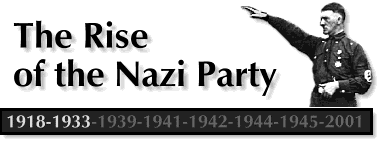
|
| |

|
| While in prison, Hitler wrote volume one of Mein Kampf (My Struggle)
After Hitler was released from prison, he formally resurrected the Nazi Party. Hitler began rebuilding and reorganizing the Party, waiting for an opportune time to gain political power in Germany. The Conservative military hero Paul von Hindenburg
The Nazi Party began building a mass movement. From 27,000 members in 1925, the Party grew to 108,000 in 1929. The SA
From 1925 to 1927, the Nazi Party failed to make inroads in the cities and in May 1928, it did poorly in the Reichstag |
|
Hindenburg's term as president was ending in the spring of 1932. At age 84, he was reluctant to run again, but knew that if he didn't, Hitler would win. Hindenburg won the election, but Hitler received 37% of the vote.
Germany's government remained on the brink of collapse. The SA brownshirts, about 400,000 strong, were a part of daily street violence. The economy was still in crisis. In the election of July 1932, the Nazi Party won 37% of the Reichstag seats, thanks to a massive propaganda campaign. For the next six months, the most powerful German leaders were embroiled in a series of desperate political maneuverings. Ultimately, these major players severely underestimated Hitler's political abilities.
A Teacher's Guide to the Holocaust |